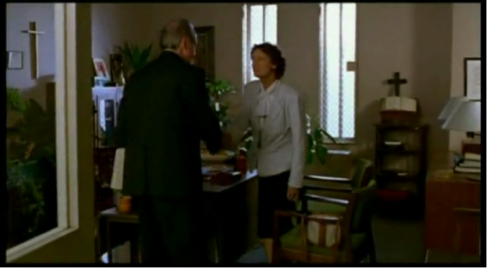One of the important aspects of Dead Man Walking (1995) was the depiction of religious concepts and symbols. In the film, the viewer encounters Sister Helen Prejean, a more “modern” Catholic nun that does not wear the habit in a time after the Second Vatican Council. Her dress is still conservative, yet does not necessarily distinguish herself as a Catholic nun. As the film begins, it is interesting that Matthew Poncelet seeks the legal help of Sister Helen, rather than spiritual guidance. However, Sister Helen accepts the challenge of helping Matthew both spiritually and legally, even though he has been convicted of rape and murder.
Image 1: Sister Helen is screened at the jail security station (Time stamp 00:04::35).
Image 2: Sister Helen meets Chaplain Farley for the first time (Time stamp 00:04::43).
After receiving Poncelet’s letter, Sister Helen arrives at the jail where he is being held. She then encounters Chaplain Farley, who is a Catholic priest. In these scenes, different crucifixes are displayed. While arriving at the jail, Sister Helen is wearing a crucifix around her neck that symbolizes the death of Jesus Christ and his resurrection. In Image 1, a security police officer at the jail wands over her crucifix, realizing this was the object that had triggered the metal detector to sound. In Image 1, the crucifix and the metal detecting wand represent the merging of “church” and “state.” The “church” aspect is represented in the religious crucifix, while the metal detecting wand represents the government and laws of the “state.” The lines between the church and state become skewed in this film since Poncelet faces the death penalty. As a Catholic nun, Sr. Helen fights for Poncelet’s right to live, even though she does not have the knowledge of whether or not he committed the crimes. In contrast, Earl Delacroix, who identifies himself as a Catholic, experiences an internal, spiritual conflict as he seeks justice for his murdered son, Walter.
In Image 2, Sister Helen greets Father Farley, the Chaplain of the jail. The background of the second image clearly displays two distinct crucifixes, one on the wall and another on a shelf. However, the following discussion between Sr. Helen and Chaplain Farley is incredibly surprising. Chaplain Farley is condescending towards Sr. Helen, asking her if she’s even been in a jail, and why she does not wear the habit. After she coolly answers his questions, Chaplain Farley explains what he has heard about the Poncelet case. Next, he bluntly asks Sr. Helen her motives by saying:
CHAPLAIN FARLEY: Do you know what you’re getting into? So what is it, Sister? Morbid fascination? Bleeding-heart sympathy?
SISTER HELEN: He wrote me and asked me to come.
CHAPLAIN FARLEY: Well there is no romance here, Sister.
In a way, Chaplain Farley seems to be insulting her motives. As the above dialogue continues, Chaplain Farley appears to have little sympathy for Poncelet. Their discourse is quite shocking since their work is guided by Christ’s sacrifice to spiritually help other individuals. Even though the crucifixes visible in Image 1 and Image 2 are symbolically equivalent, Sr. Helen and Chaplain Farley’s attitudes towards Poncelet, and thus their ministries, are incredibly different.
Another religious concept displayed in this film is that of reconciliation. In the Catholic Church, reconciliation is one of the seven Sacraments. Other Sacraments include Baptism, Confirmation, and Matrimony. Before he is executed, Matthew Poncelet confesses to Sr. Helen that he is guilty of killing Water Delacroix and raping Hope Percy. While some may see his confession as a type of “reconciliation,” this would not be considered a valid Reconciliation in the Catholic Church. A priest must be the individual to hear a sinner’s confession, while the sinner must also truly repent his or her sins. Even though Poncelet admits his guilt and claims to be sorry for his crimes, the viewer will never know if he was truly remorseful.
-Paige T.



